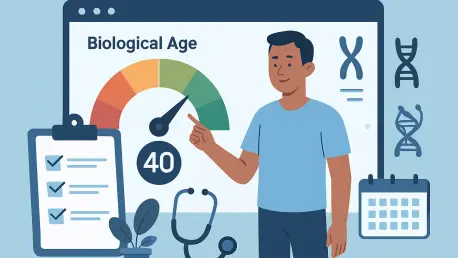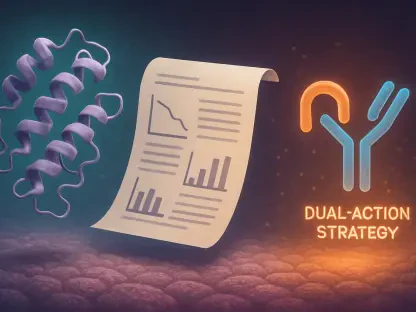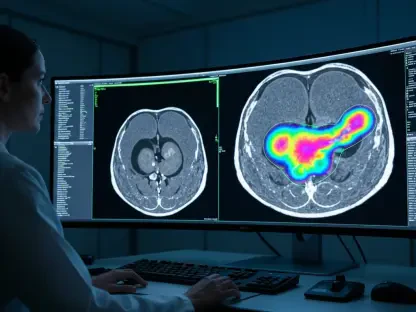In the ever-evolving world of biopharma and medical research, experts like Ivan Kairatov are at the frontier of innovation. With profound expertise in technology and development within the sector, Ivan sheds light on a groundbreaking development that could redefine how we understand aging. The newly developed Transcriptomic Mortality-risk Age (TraMA) uses RNA sequencing to provide a more nuanced measure of biological age, rivaling traditional methods and offering insights into health risks. Join us as we delve into this transformative research and explore its significance with Ivan.
Can you explain the concept of biological age and how it differs from chronological age?
Biological age reflects the state of your body’s functions, unlike chronological age, which is simply the number of years you’ve lived. Biological age can give a more accurate picture of your health and risk factors for age-related conditions, as it takes into account how well your systems are functioning, which can vary widely among people of the same chronological age.
What inspired the development of Transcriptomic Mortality-risk Age (TraMA)?
TraMA was inspired by the need for a more dynamic and comprehensive approach to measuring biological age. Previous methods, like DNA methylation and blood biomarkers, have provided valuable insights, but they lacked the ability to fully capture gene expression changes. We wanted to develop a tool that could better reflect real-time biological processes and predict health outcomes with greater specificity.
Could you describe the process of creating TraMA? What were the key steps involved?
Creating TraMA involved extensive RNA sequencing to gather comprehensive gene expression data. We started by analyzing data from a large, diverse sample of individuals aged 50 and older. This allowed us to identify gene expression patterns strongly associated with mortality risk. From there, we developed an algorithm to predict biological aging based on these patterns, and validated it across multiple datasets.
How does TraMA utilize RNA sequencing data to predict health risks and mortality?
TraMA uses RNA sequencing data to evaluate gene activity related to essential biological processes like inflammation and immune response. By measuring these activities, it assesses an individual’s biological age and predicts their risk for poor health outcomes, including early death. This predictive capability is especially useful in identifying elevated health risks that might not be evident through traditional measures.
What makes TraMA distinct from other biological aging measures like DNA methylation and blood biomarkers?
Unlike DNA methylation, which captures long-term biological changes, and blood biomarkers, which provide snapshots of specific health indicators, TraMA captures active gene expression patterns that show how biological processes are functioning in real time. This allows for a more dynamic and comprehensive understanding of aging and related health risks.
How reliable is TraMA compared to existing RNA-based aging measures?
TraMA significantly improves reliability through its use of modern RNA sequencing and analysis of a large, representative dataset. This robustness surpasses earlier RNA-based measures that might have been limited by smaller or less diverse samples, ensuring TraMA’s findings are broadly applicable and reliable.
What were the criteria for selecting participants in the study, and why focus on individuals aged 50 and older?
We focused on individuals aged 50 and older because this is typically when age-related changes and risks become more pronounced. Selecting participants from this demographic allowed us to capture the full spectrum of gene expression changes that significantly impact health and mortality in older adults.
Can you elaborate on TraMA’s ability to predict various health outcomes like chronic diseases and cognitive decline?
TraMA’s predictive power lies in its ability to assess gene expression related to essential aging processes. This leads to precise predictions of the onset or progression of chronic diseases, cognitive decline, and other age-related health challenges. By doing so, it helps identify high-risk individuals early, potentially improving intervention strategies.
How was TraMA validated across different populations and health conditions? Can you share more details about this phase of the research?
We validated TraMA across several populations by analyzing diverse datasets, including those with conditions like diabetes, sepsis, and cancer. This comprehensive validation ensured TraMA’s robustness and accuracy in predicting mortality and health outcomes irrespective of specific health conditions or demographics.
How does TraMA track biological processes related to inflammation and immune function?
TraMA leverages RNA sequencing to track gene expressions linked to inflammation and immune responses effectively. These expressions are crucial in understanding aging processes, as changes in these biological systems can signify accelerated aging and health decline, which TraMA can detect.
What were your observations regarding the association of lifestyle factors like smoking and obesity with TraMA scores?
Lifestyle factors like smoking and obesity were strongly correlated with older TraMA scores, illustrating that these behaviors significantly impact biological aging. This association highlights the role of lifestyle choices in accelerating aging and emphasizes the importance of healthy living in extending lifespan.
Can TraMA respond to changes in health status over time, and how does this ability enhance its effectiveness?
Yes, TraMA can track changes over time. By measuring at different time points, it remains sensitive to changes in a person’s health status, adjusting predictions accordingly. This dynamic responsiveness enhances TraMA’s effectiveness as an ongoing tool for monitoring biological age and reducing health risks as they evolve.
What advantages does TraMA offer over tools like GrimAge and PhenoAge?
One of the most significant advantages of TraMA over tools like GrimAge and PhenoAge is its ability to capture real-time changes in gene activity, providing a more immediate reflection of a person’s biological state. This adaptability offers a clearer picture of health trajectories and potential interventions.
How do you envision TraMA being used in public health applications?
In public health, TraMA could be instrumental in early detection and prevention strategies, enabling targeted interventions for at-risk populations. Its ability to provide detailed insights into biological health will help tailor public health strategies, identify emerging health trends, and improve population health management.
Are there any potential limitations or challenges associated with TraMA?
One challenge with TraMA is ensuring consistent data quality across varied populations and environments. There’s also the necessity of integrating genetic and lifestyle information comprehensively. We must also navigate privacy and ethical considerations related to genetic data handling.
How might TraMA contribute to ongoing research on extending lifespan and improving health outcomes?
TraMA’s detailed aging insights could revolutionize lifespan and health outcomes research by pinpointing genetic expressions and lifestyle factors that most influence aging. This knowledge paves the way for innovative therapies and preventive measures tailored to maintaining health and extending life.
Could TraMA potentially be customized or adapted for individual use?
Absolutely, TraMA could be adapted for personal health management, tailoring interventions based on one’s unique genetic and lifestyle profile. This customization would enable individuals to make informed decisions to better manage their long-term health and aging processes.
What are the next steps for research on TraMA following its development and validation?
The next steps include expanding TraMA’s application to younger populations and further refining its predictive capabilities. We also aim to integrate TraMA with AI technologies, advancing its precision and usability as a routine health assessment tool.
How might TraMA influence the understanding of gene, lifestyle, and environmental impacts on aging?
TraMA offers a rich framework for understanding how genes, lifestyle, and environment interplay to influence aging. By analyzing these factors collectively, it stands to redefine our understanding of aging mechanisms and promote more holistic health interventions.
In what ways do you think TraMA could change how researchers approach studies on aging in the future?
TraMA could fundamentally shift aging research by encouraging a focus on real-time biological changes rather than static indicators. This shift could lead researchers to uncover novel aging pathways and therapeutic targets that remain hidden or overlooked by traditional aging measures.









